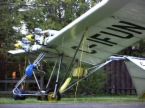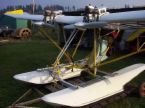|
Lazair UltralightThe inventor, the ideas man, the maker of the Lazair was a young man by the name of Dale Kramer who was at the time studying aeronautical engineering. Dale quite liked the idea of an ultralight airplane and decided to create his own design. Obviously his design is a winner as even today these ultralight aircraft are still well sought after and have an impeccable ultralight flying record. Obviously purchasing any style of aircraft can be very expensive, particularly if you need financial assistance. Airplane financing is not so difficult when purchasing an ultralight aircraft.
Lazy-Air Ultralight kitsThe year 1978 was a very exciting year for Dale Kramer and his business partner Peter Corley as this was the year that their prototype first flew. In addition to using standard airplane building materials for construction new design concepts were introduced, such as:- * the ultralight wings had "winglets" which are the raised up portion of the wing situated at the very ends. * 3-axis control - pitch, yaw and roll. This was quite rare back in 1978. * an inverted "V-tail" with ruddervators * fitted with 2 chainsaw engines each producing 5.5hp and having 100cc capacity. The ultralight engines were placed close together to reduce the yawing effect on the wings should one engine stop. Each airplane was sold as ultralight kits. This of course included all the ultralight plans with diagrams included to assist with the construction. This aircraft was not classified as an ultralight that is homebuilt, as one needed to actually purchase all the materials themselves. A person who purchases a homebuilt ultralight only pays for the ultralight plans, usually for a bargain price in comparison to purchasing one fully constructed.

Lazair amphibious ultralightThe day came when Kramer had to make the original ultralight engines obsolete. This was mainly due to the increasing pressure he was getting to add ultralight floats to his airplanes. So he introduced two fire fighting pump engines, each engine having a 9.5hp output and a good reliability record as well. In addition Dale added an extra propeller blade on top of the existing ones thereby having two stacked "bi-plane propellers". Yet again the university flight engineer student excels himself by creating his own amphibious ultralight. Ultralight gliderDue to the size of the ultralight wings which originally measured approx. 36' or 11 metres, the Lazair was considered to be an ultralight glider. With wings this size the airplane could soar in thermals and have both engines set at idle. The ultralight flight time of the "lazy-air" ultralight company was 5 years. The company was closed down due to financial issues. However the airplane itself is still alive and well and has many enthusiasts around the world. Although this ultralight had a very small beginning putting Canada on the map as far as ultralights go, they continue to maintain a high appreciation amongst ultralight pilots throughout the world. Ultralight specificationsThe specifications given below are particular to the one man ultralight airplane although two seaters still exist today. Length - 13' or 4 metres Max. Speed - 55mph or 90km/hCruise Speed - 45 mph or 73km/hStall Speed - 17mph or 28km/hRange - 135 miles or 218kmClimb Rate - 200' per min. or 61 metres per min. View the amazing Lazair ultralight by clicking here.
Last flight to Airplane and Aircraft.com home page.
|





